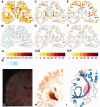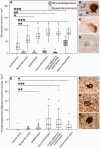The topograpy of demyelination and neurodegeneration in the multiple sclerosis brain
- PMID: 26912645
- PMCID: PMC4766379
- DOI: 10.1093/brain/awv398
The topograpy of demyelination and neurodegeneration in the multiple sclerosis brain
Abstract
Multiple sclerosis is a chronic inflammatory disease with primary demyelination and neurodegeneration in the central nervous system. In our study we analysed demyelination and neurodegeneration in a large series of multiple sclerosis brains and provide a map that displays the frequency of different brain areas to be affected by these processes. Demyelination in the cerebral cortex was related to inflammatory infiltrates in the meninges, which was pronounced in invaginations of the brain surface (sulci) and possibly promoted by low flow of the cerebrospinal fluid in these areas. Focal demyelinated lesions in the white matter occurred at sites with high venous density and additionally accumulated in watershed areas of low arterial blood supply. Two different patterns of neurodegeneration in the cortex were identified: oxidative injury of cortical neurons and retrograde neurodegeneration due to axonal injury in the white matter. While oxidative injury was related to the inflammatory process in the meninges and pronounced in actively demyelinating cortical lesions, retrograde degeneration was mainly related to demyelinated lesions and axonal loss in the white matter. Our data show that accumulation of lesions and neurodegeneration in the multiple sclerosis brain does not affect all brain regions equally and provides the pathological basis for the selection of brain areas for monitoring regional injury and atrophy development in future magnetic resonance imaging studies.
Keywords: cerebral arteries; cerebral veins; demyelination; multiple sclerosis; neurodegeneration.
© The Author (2016). Published by Oxford University Press on behalf of the Guarantors of Brain.
Figures



References
-
- Abbott NJ . Evidence for bulk flow of brain interstitial fluid: significance for physiology and pathology . Neurochem Int 2004. ; 45 : 545 – 52 . - PubMed
-
- Aboul-Enein F, Rauschka H, Kornek B, Stadelmann C, Stefferl A, Bruck W, et al. . Preferential loss of myelin-associated glycoprotein reflects hypoxia-like white matter damage in stroke and inflammatory brain diseases . J Neuropathol Exp Neurol 2003. ; 62 : 25 – 33 . - PubMed
-
- Bo L, Vedeler CA, Nyland H, Trapp BD, Mork SJ . Intracortical multiple sclerosis lesions are not associated with increased lymphocyte infiltration . Mult Scler 2003. ; 9 : 323 – 31 . - PubMed
Publication types
MeSH terms
Grants and funding
LinkOut - more resources
Full Text Sources
Other Literature Sources
Medical

